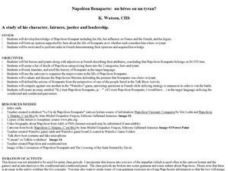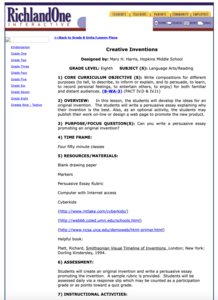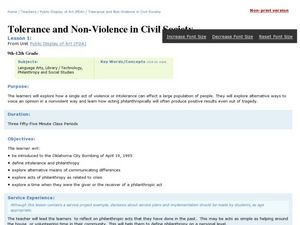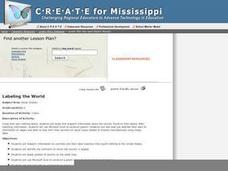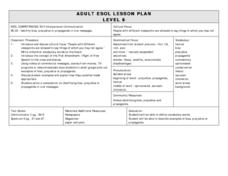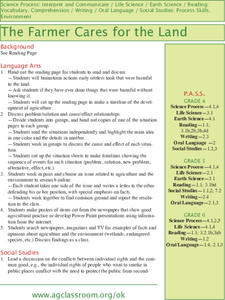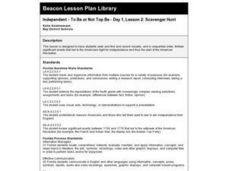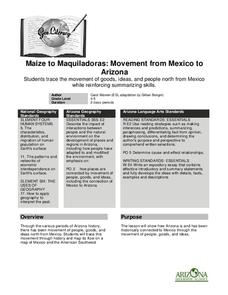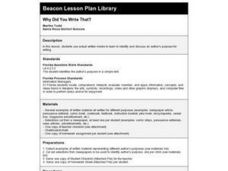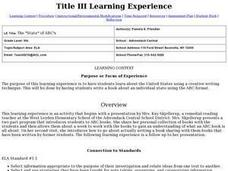Curated OER
Discrimination and Media: Focus on Mental Health
Students explore discrimination by the media. In this media awareness instructional activity, students examine stigmas concerning mental illnesses as they are portrayed in the media.
Smithsonian Institution
Mary Henry: Journal/Diary Writing
A great way to connect social studies with language arts, a resource on Mary Henry's historical diary reinforces the concepts of primary and secondary sources. It comes with an easy-to-understand lesson plan, as well as the reference...
Curated OER
Columbus: Hero or Villain?
Students explore Christopher Columbus's motives. In this character education lesson plan, students research Internet and print sources regarding the life and actions of Christopher Columbus in order to write essays that his actions as...
Curated OER
Writing Author's Purpose
Write in all three authorial purposes (persuasive, informational, entertaining) with this lesson. Young writers consider a time when a friend of theirs helped them out and gave them advice on something. They write a short paragraph (no...
Bantam Books
The Tempest: Chalk Talk
Discussion doesn't always need to be spoken. Before you begin The Tempest by William Shakespeare, have kids connect their ideas and experiences to central questions of the play with a silent discussion activity. Once they have...
Curated OER
Napoléon Bonaparte: un héros ou un tyran?
Was Napoléon Bonaparte a hero or a tyrant? Discuss examples of each, and list their common attributes. Then, to form a solid argument and take a stance, intermediate and advanced Francophones conduct Internet research. After a few days...
Curated OER
Cite Right
What do you need to cite, and how can you avoid plagiarizing? This presentation is aimed at beginning writers, and it details some of the ways people plagiarize (even accidentally) and what sort of information needs to be cited. The best...
Curated OER
Creative Inventions
Ninth graders develop ideas for an invention and write a persuasive essay explaining why their invention is best. In this invention essay lesson, 9th graders review persuasive essay writing. Students create a graphic web for an original...
Curated OER
Tolerance and Non-Violence in Civil Society
Students explore the concept of philanthropy. In this Oklahoma City bombing lesson, students submit public responses to the event in order to consider how the tragedy prompted a positive reaction. Extension activities are included.
Curated OER
Labeling the World
Sixth graders conduct research on the countries found on the labels on their clothing. They locate the countries on a map, research the labor practices on countries that export clothing to the U.S., and create a graph using the information.
Curated OER
Strategic Skill: Evaluating Information Quality Using Electronic Sources
Fourth graders review and complete evaluating information quality. In groups, they research the diversity of the numerous Native American tribes in Montana. They complete a worksheet on evaluating sources on the Internet and share...
Curated OER
Independent - To Be or Not Top Be - Day 2, Lesson 3: In the Course of Human Events
Fifth graders practice scanning skills to answer questions on the French and Indian War.
Curated OER
Agree To Disagree
Young scholars discover their own talents and preferences and determine how they apply to the world of work with a group activity. They express their choice and discuss their positions.
Curated OER
The Farmer Cares for the Land
Students identify cause and effect relationships in issues relating to agriculture and the environment.
Curated OER
Independent - To Be or Not Top Be - Day 1, Lesson 2: Scavenger Hunt
Fifth graders research the thirteen significant events that lead to the start of the American Revolution.
Curated OER
Using "Why Mosquitoes Buzz in People's Ears" to Teach Cause and Effect
Students discuss cause and effect relationships and the chain reaction involved before listening to the story "Why Mosquitoes Buzz in People's Ears". Students create flow charts to show the chain reactions of causes and effects in the...
Curated OER
Maize to Maquiladoras: Movement from Mexico to Arizona
Students label maps of Arizona and Mexico of the products that moved from one place to another. In this Arizona and Mexico lesson plan, students also summarize the effects of the movement on life in Arizona.
Curated OER
Technology-commected Folklife Lesson Plan: Fables
Learners discuss ways the stories were alike and different. The teacher demonstrate how to draw a Venn diagram using Microsoft Word. They label the two circles and enter the likenesses and differences on the diagram.
Curated OER
Unknown Element Project
Students work with a partner to determine the identity of an unknown element based on given descriptions. Groups use classroom textbooks, encyclopedias, and science internet sites to identify their unknown element then write a report as...
Curated OER
Maize to Maquiladoras: Movement from Mexico to Arizona
Fourth graders label maps of Arizona and Mexico to show the people, goods, and ideas that have moved between the two places. In this Arizona and Mexico lesson plan, 4th graders summarize the effects of the movement on Arizona life.
Curated OER
A River Through Time
Learners explore how construction of a dam on the Gila River affected the lifestyle of Pima Indians. In this social studies lesson, students locate the Gila River and the Coolidge Dam. Learners record dates on a timeline and discuss how...
Curated OER
Why Did You Write That?
Second graders use actual written media to identify and discuss an author's purpose for writing. They identify the author's purpose in a selection from the newspaper, and write a short description of how they came to their conclusion.
Curated OER
The "State" of ABC's
Fifth graders apply the ABC format to write books about various states. They identify important people, places, and events and include title. copyright, and dedication pages. They have items for all letters and createcovers and "about...
Curated OER
The Cycle of Life
Eighth graders search for rites of passage in their own lives and study rites of other cultural groups in Louisiana and around the world. They assess how to recognize moments of importance in people's lives and find meaning in the stages...







